Identification and Optimization of Ecological Network in Arid Inland River Basin Using MSPA and Spatial Syntax: A Case Study of Shule River Basin, NW China
Abstract
:1. Introduction
2. Study Area and Data
2.1. Study Area
2.2. Data
3. Methods
3.1. Ecological Sources Extraction
3.1.1. Identification of Landscape Elements Using MSPA
3.1.2. Selecting Ecological Sources Based on Landscape Connectivity
3.2. Build the Comprehensive Resistance Surface
3.3. Simulate Potential Ecological Corridors
3.3.1. Simulation of Potential Optimal Paths Based on MCR
3.3.2. Simulating Potential Sub-Optimal Paths Using Circuit Theory
3.4. Evaluation of ENs Based on Spatial Syntax
4. Results
4.1. EN Identification Results
4.1.1. Landscape Element Identification Results
4.1.2. Location Selection Results Based on Landscape Connectivity Index
4.1.3. Optimal Path Simulation Results Based on MCR
4.1.4. Simulation Results of Sub-optimal Path Based on Circuit Theory
4.2. EN Evaluation Results
4.3. Optimization Results of EN
4.3.1. Determine the Protection Priority of Ecological Sources
4.3.2. Determine the Optimal Expansion Distance of the Ecological Source
4.3.3. Determining the Priority of Ecological Corridor Protection
4.3.4. Construct Ecological Nodes to Optimize the EN
5. Discussion
5.1. Comparison with Similar Studies
5.2. Construction of Ecological Security Pattern
5.2.1. Repairing Ecological “Pinch Points” and Clearing Ecological Obstacle Points
5.2.2. Determine the Optimal Width of the Ecological Corridor
5.2.3. Propose the Main Spatial Pattern of Green Network Construction
- (1)
- Jinta oasis ecological control zone. Several ecological source areas in Jinta County, the northernmost part of the basin, were the core. The land use types of the source areas were water, wetland, and grassland, while the other areas were bare soil, bare rock, Gobi, and other unused land, with high ecological resistance and poor habitat quality. Different degrees of soil salinization have appeared in the oasis area. The farmland in oasis should solve the problems of irrigation and drainage, prevent salinization, adjust the structure of crops, reduce the area of crops with high water consumption, protect and restore the Haloxylon ammodendron forest and Populus euphratica forest along the Heihe River, control grazing intensity, prevent degradation of vegetation, and strictly control the land reclamation. In the desert area, human activities should be strictly controlled, especially the influence of grazing activities on the area, and the existing desert vegetation should be protected to reduce the harm of wind erosion and desertification.
- (2)
- Qiwen ecological conservation area. The ecological source 34 is the core of this area, which is connected with several important ecological corridors and has high landscape connectivity. It is an important hub for species migration in the basin.
- (3)
- Piedmont ecological restoration area. With the No. 36 ecological source as the core, the area is 410.82 km2, and the land use type is mainly shrub land, which is an important ecological conservation area in the watershed. However, the surrounding areas are mainly alpine bare rock, bare land, farmland, and other areas with high ecological resistance, which hinder the migration channels of species. The restoration and connection of ecological corridors in this area should be strengthened.
- (4)
- Hongshui Dam ecological protection area. The area takes the No. 37 ecological source area as the core, with a total area of 657.12 km2, second only to the No. 38 ecological source, and is rich in water resources, mainly from the Qilian mountain snow melt water; the ecological conditions of the Flood Dam Ecological Reserve are directly related to the survival and development of Jiuquan City, Jinta County oasis and Jiayuguan City. All kinds of unsustainable human activities should be prohibited in this area; water conservation and biodiversity protection should be protected.
- (1)
- Ecological corridor construction zone of Jiajiu Oasis. The grassland and farmland of Jiayuguan City and Suzhou District of Jiuquan City are scattered with some ecological sources with small areas, which are connected by several important ecological corridors with relatively close distance and high connectivity, and together constituting the oasis ecological corridors. In recent years, Jiuquan City of Jiayuguan City has developed rapidly, the scale of regional population, industry and agriculture has expanded, and all kinds of resources are tight. Under the pressure of urbanization, we should take the regional ecological carrying capacity as the premise, and give priority to the construction of ecological corridors, so as to provide better ecosystem services for urban population.
- (2)
- Ecological corridor construction belt of grassland and water area in Qilian Mountain. The ecological corridor construction zone is mainly composed of grassland and water land, close to the side of the Hongshui River, and has excellent ecological background conditions. It is an important ecological corridor to realize the connection of various ecological sources in the upper reaches of the basin.
- (3)
- Ecological corridor construction zone on the eastern side of the basin. The ecological corridor construction belt connects the ecological core area No. 37, 36, 12, 1, and 33, and other large ecological sources from south to north. The connectivity of ecological corridors is high, and the upstream, middle, and downstream ecological sources are connected in the east of the basin. The protection and construction of this ecological corridor is of great significance.
- (4)
- Main belt of ecological corridor construction in the western part of the basin. The ecological corridor construction belt connects the ecological core area No. 34, No. 9, and No. 33, and other large ecological sources from south to north, and connects the upstream, middle, and downstream ecological sources in the west side of the watershed, which is of great significance for the construction of the green network system of the watershed. However, some corridors of this construction zone are too long, and the land use is mainly bare land and other unused land, which spans the urban area. In practice, the protection and construction of ecological nodes and urban green landscape should be considered first.
- (5)
- Sub-zone of ecological corridor construction on the west side of the watershed. The ecological corridor construction belt connects the ecological core area No. 24 and No. 25, and other ecological sources with high priority, and intersects with the main ecological corridor construction belt on the west side of the watershed to the No. 9 ecological source in Jiayuguan City, forming the ecological corridor construction belt on the west side of the watershed. The five ecological corridor construction zones showed a spatial pattern of “three vertical and two horizontal”. Among them, the eastern side of the watershed and the ecological corridor construction zones of the grassland and water area of Qilian Mountain were all composed of important ecological corridors, with better ecological background conditions and higher priority. The “five belts” connected the “one core” and the “four rings” to form a green network system with both spatial connectivity and landscape ecological functions in the basin [45].
5.3. Limitation
6. Conclusions
- (1)
- The ecological space of Taolai River Basin is insufficient and the spatial distribution is uneven. MSPA and landscape connectivity index were used to identify 38 ecological sources with a total area of 3061.63 km2, accounting for 19.34% of the watershed area, mainly distributed in Qilian mountains.
- (2)
- The ecological corridors in the Taolai River Basin were generally long, which was not conducive to species migration. The MCR model was used to simulate 106 optimal ecological corridors, with a total length of 2267.30 km and an average length of 21.38 km. The circuit theory was used to simulate the sub-optimal ecological corridors with a certain width distributed in the surrounding areas of the optimal ecological corridors. The minimum and maximum integration degree of the EN were 0.139 and 0.334, respectively. The connection degree of each ecological space in the watershed was too low.
- (3)
- According to the Taolai River Basin ecological environment present situation, optimization measures such as priority protection of key ecological space, optimal expansion distance of ecological source, optimal width of ecological corridor construction, ecological node construction, ecological “pinch-point” restoration, ecological obstacle point removal, and the main spatial pattern of “one core, four rings, and five belts” for watershed EN construction were proposed. This study can provide a scientific reference for the EN construction and biodiversity protection in the Taolai River Basin.
Author Contributions
Funding
Data Availability Statement
Conflicts of Interest
References
- European Parliament and European Council. Directive 2009/147/EC of the European Parliament and of the Council of 30 November 2009 on the Conservation of Wild Birds. Off. J. Lang. 2009, 20, 7–25. [Google Scholar]
- Yang, R.; Cao, Y.; Hou, S.Y.; Peng, Q.Y.; Wang, X.S.; Wang, F.Y.; Tseng, T.H.; Yu, L.; Carver, S.; Convery, I.; et al. Cost-effective priorities for the expansion of global terrestrial protected areas: Setting post-2020 global and national targets. Sci. Adv. 2020, 6, eabc3436. [Google Scholar] [CrossRef]
- Nie, W.B.; Shi, Y.; Siaw, M.J.; Yang, F.; Wu, R.W.; Wu, X.; Zheng, X.Y.; Bao, Z.Y. Constructing and optimizing ecological network at county and town Scale: The case of Anji County, China. Ecol. Indic. 2021, 132, 108294. [Google Scholar] [CrossRef]
- Chetcuti, J.; Kunin, W.E.; Bullock, J.M. Habitat fragmentation increases overall richness, but not of habitat-dependent species. Front. Ecol. Evol. 2020, 8, 12. [Google Scholar] [CrossRef]
- Liu, S.L.; Yin, Y.J.; Cheng, F.Y.; Hou, X.Y.; Dong, S.K.; Wu, X. Spatio-temporal variations of conservation hotspots based on ecosystem services in Xishuangbanna, Southwest China. PLoS ONE 2017, 12, e0189368. [Google Scholar] [CrossRef] [PubMed] [Green Version]
- Shi, F.N.; Liu, S.L.; An, Y.; Sun, Y.X.; Zhao, S.; Liu, Y.X.; Li, M.Q. Spatio-temporal dynamics of landscape connectivity and ecological network construction in Long Yangxia Basin at the Upper Yellow River. Land 2020, 9, 265. [Google Scholar] [CrossRef]
- Leonard, P.B.; Sutherland, R.W.; Baldwin, R.F.; Fedak, D.A.; Carnes, R.G.; Montgomery, A.P. Landscape connectivity losses due to sea level rise and land use change. Anim. Conserv. 2016, 20, 80–90. [Google Scholar] [CrossRef]
- Theobald, D.M.; Crooks, K.R.; Norman, J.B. Assessing effects of land use on landscape connectivity: Loss and fragmentation of western U.S. forests. Ecol. Appl. 2011, 21, 2445–2458. [Google Scholar] [CrossRef]
- Jongman, R.H.G. Landscape planning for biological diversity in Europe. Landscape Res. 2002, 27, 187–195. [Google Scholar] [CrossRef]
- Wang, C.X.; Yu, C.Y.; Chen, T.Q.; Feng, Z.; Hu, Y.C.; Wu, K.N. Can the establishment of ecological security patterns improve ecological protection? An example of Nanchang, China. Sci. Total Environ. 2020, 740, 140051. [Google Scholar] [CrossRef]
- Zhang, L.Q.; Peng, J.; Liu, Y.X.; Wu, J.S. Coupling ecosystem services supply and human ecological demand to identify landscape ecological security pattern: A case study in Beijing–Tianjin–Hebei region, China. Urban Ecosyst. 2017, 20, 1–14. [Google Scholar] [CrossRef]
- Wang, X.M.; Wen, Y.Y.; Liu, X.C.; Wen, D.; Long, Y.X.; Zhao, P.; Liu, P.A.; Zhong, J. Protection effect and vacancy of the ecological protection redline: A case study in Guangdong–Hong Kong–Macao Greater Bay Area, China. Remote Sens. 2021, 13, 5171. [Google Scholar] [CrossRef]
- Wang, Y.J.; Qu, Z.Y.; Zhong, Q.C.; Zhang, Q.P.; Zhang, L.; Zhang, R.; Yi, Y.; Zhang, G.L.; Li, X.C.; Liu, J. Delimitation of ecological corridors in a highly urbanizing region based on circuit theory and MSPA. Ecol. Indic. 2022, 142, 109258. [Google Scholar] [CrossRef]
- Wei, Q.Q.; Halike, A.; Yao, K.X.; Chen, L.M.; Balati, M. Construction and optimization of ecological security pattern in Ebinur Lake Basin based on MSPA-MCR models. Ecol. Indic. 2022, 138, 108857. [Google Scholar] [CrossRef]
- Riitters, K.H.; Vogt, P.; Soille, P.; Kozak, J.; Estreguil, C. Neutral model analysis of landscape patterns from mathematical morphology. Landscape Ecol. 2007, 22, 1033–1043. [Google Scholar] [CrossRef]
- Ding, M.M.; Liu, W.; Xiao, L.; Zhong, F.X.; Lu, N.; Zhang, J.; Zhang, Z.H.; Xu, X.; Wang, K.L. Construction and optimization strategy of ecological security pattern in a rapidly urbanizing region: A case study in central-south China-ScienceDirect. Ecol. Indic. 2022, 136, 108604. [Google Scholar] [CrossRef]
- Dickson, B.G.; Albano, C.M.; Mcrae, B.H.; Anderson, J.J.; Theobald, D.M.; Zachmann, L.J.; Sisk, T.D.; Dombeck, M.P. Informing strategic efforts to expand and connect protected areas using a model of ecological flow, with application to the Western United States. Conserv. Lett. 2017, 10, 564–571. [Google Scholar] [CrossRef]
- Yang, T.X.; Jing, D.; Wang, S.B. Applying and exploring a new modeling approach of functional connectivity regarding EN: A case study on the dynamic lines of space syntax. Ecol. Modell. 2015, 318, 126–137. [Google Scholar] [CrossRef]
- Chen, B.S.; Zhao, B.; Li, Y.; Yu, Q.Y.; Zhao, B.J.; Tan, J.Y.; Wen, C.H. Spatiotemporal evolution and factors influencing ecological civilization development in Chinese watersheds. Int. J. Environ. Res. Public Health 2022, 19, 10728. [Google Scholar] [CrossRef] [PubMed]
- Zhai, L.; Cheng, S.Y.; Sang, H.Y.; Xie, W.H.; Gan, L.; Wang, T.B. Remote sensing evaluation of ecological restoration engineering effect: A case study of the Yongding River Watershed, China. Ecol. Eng. 2022, 182, 106724. [Google Scholar] [CrossRef]
- Li, Z.X.; Qi, F.; Li, Z.J.; Wang, X.F.; Juan, G.; Zhang, B.J.; Li, Y.C.; Deng, X.H.; Jian, X.; Gao, W.D.; et al. Reversing conflict between humans and the environment—The experience in the Qilian Mountains. Renew. Sustain. Energy Rev. 2021, 148, 111333. [Google Scholar] [CrossRef]
- Liu, J.; Jin, X.B.; Xu, W.Y.; Fan, Y.T.; Ren, J.; Zhang, X.L.; Zhou, Y.K. Spatial coupling differentiation and development zoning trade-off of land space utilization efficiency in eastern China. Land Use Pol. 2019, 85, 310–327. [Google Scholar] [CrossRef]
- Cui, L.; Wang, J.; Sun, L.; Lv, C.D. Construction and optimization of green space ecological networks in urban fringe areas: A case study with the urban fringe area of Tongzhou district in Beijing. J. Clean. Prod. 2020, 276, 124266. [Google Scholar] [CrossRef]
- Wang, T.; Li, H.B.; Huang, Y. The complex ecological network’s resilience of the Wuhan metropolitan area. Ecol. Indic. 2021, 130, 108101. [Google Scholar] [CrossRef]
- Wang, Q.B.; Liu, S.L.; Liu, Y.X.; Wang, F.F.; Liu, H.; Yu, L. Effects of urban agglomeration and expansion on landscape connectivity in the river valley region, Qinghai-Tibet Plateau. Global. Ecol. Conserv. 2022, 34, e02004. [Google Scholar] [CrossRef]
- Huang, X.X.; Wang, H.J.; Shan, L.Y.; Xiao, F.T. Constructing and optimizing urban ecological network in the context of rapid urbanization for improving landscape connectivity. Ecol. Indic. 2021, 132, 108319. [Google Scholar] [CrossRef]
- Niyogi, R.; Sarkar, M.S.; Niyogi, V.S.; Hazra, P.; John, R. Habitat connectivity for conserving cervids in a multifunctional landscape. J. Nat. Conserv. 2022, 68, 126212. [Google Scholar] [CrossRef]
- Chen, H.Y.; Li, X. Optimization of green space habitat network in beijing central urban area based on MSPA-InVEST Model. Landsc. Archit. 2021, 28, 16–21. [Google Scholar] [CrossRef]
- Liu, S.L.; Deng, L.; Dong, S.K.; Zhao, Q.H.; Yang, J.J.; Wang, C. Landscape connectivity dynamics based on network analysis in the Xishuangbanna Nature Reserve, China. Acta Oecol. 2014, 55, 66–77. [Google Scholar] [CrossRef]
- Mu, H.W.; Li, X.C.; Ma, H.J.; Du, X.P.; Huang, J.X.; Su, W.; Yu, Z.; Xu, C.; Liu, H.L.; Yin, D.Q.; et al. Evaluation of the policy-driven ecological network in the Three-North Shelterbelt region of China-Science Direct. Landsc. Urban Plann. 2022, 218, 104305. [Google Scholar] [CrossRef]
- Ran, Y.J.; Lei, D.M.; Li, J.; Gao, L.P.; Mo, J.X.; Liu, X. Identification of crucial areas of territorial ecological restoration based on ecological security pattern: A case study of the central Yunnan urban agglomeration, China. Ecol. Indic. 2022, 143, 109318. [Google Scholar] [CrossRef]
- Xu, H.Q.; Wang, Y.F.; Guan, H.D.; Shi, T.T.; Hu, X.S. Detecting ecological changes with a remote sensing based ecological index (RSEI) produced time series and change vector analysis. Remote Sens. 2019, 11, 2345. [Google Scholar] [CrossRef] [Green Version]
- Kang, J.M.; Zhang, X.; Zhu, X.W.; Zhang, B.L. Ecological security pattern: A new idea for balancing regional development and ecological protection. A case study of the Jiaodong Peninsula, China. Global. Ecol. Conserv. 2021, 26, e01472. [Google Scholar] [CrossRef]
- Li, Y.G.; Liu, W.; Feng, Q.; Zhu, M.; Yang, L.S.; Zhang, J.T.; Yin, X.W. The role of land use change in affecting ecosystem services and the ecological security pattern of the Hexi Regions, Northwest China. Sci. Total Environ. 2023, 855, 158940. [Google Scholar] [CrossRef]
- Knaapen, J.P.; Scheffer, M.; Harms, B. Estimating habitat isolation in landscape planning. Landsc. Urban Plann. 1992, 23, 1–16. [Google Scholar] [CrossRef]
- Machado, R.; Godinho, S.; Guiomar, N.; Gil, A.; Pirnat, J. Using graph theory to analyse and assess changes in Mediterranean woodland connectivity. Landsc. Ecol. 2020, 35, 1291–1308. [Google Scholar] [CrossRef]
- Mcrae, B.H.; Beier, P. Circuit theory predicts gene flow in plant and animal populations. Proc. Natl. Acad. Sci. USA 2007, 104, 19885–19890. [Google Scholar] [CrossRef] [PubMed] [Green Version]
- Xia, C.; Zhang, A.Q.; Wang, H.J.; Yeh, A.G. Predicting the expansion of urban boundary using space syntax and multivariate regression model. Habitat Int. 2019, 86, 126–134. [Google Scholar] [CrossRef]
- Liu, M.; Nijhuis, S. Mapping landscape spaces: Methods for understanding spatial-visual characteristics in landscape design. Environ. Impact Assess. Rev. 2020, 82, 106376. [Google Scholar] [CrossRef]
- Alalouch, C.; Al-Hajri, S.; Naser, A.; Al Hinai, A. The impact of space syntax spatial attributes on urban land use in Muscat: Implications for urban sustainability. Sustain. Cities Soc. 2019, 46, 101417. [Google Scholar] [CrossRef]
- Pan, N.H.; Du, Q.Q.; Guan, Q.Y.; Tan, Z.; Sun, Y.F.; Wang, Q.Z. Ecological security assessment and pattern construction in arid and semi-arid areas: A case study of the Hexi Region, NW China. Ecol. Indic. 2022, 138, 108797. [Google Scholar] [CrossRef]
- Wei, J.Q.; Zhang, Y.; Liu, Y.; Li, C.; Tian, Y.S.; Qian, J.; Gao, Y.; Hong, Y.S.; Liu, Y.F. The impact of different road grades on ecological networks in a mega-city Wuhan City, China. Ecol. Indic. 2022, 137, 108784. [Google Scholar] [CrossRef]
- Schalkwyk, J.V.; Pryke, J.S.; Samways, M.J.; Gaigher, R. Corridor width determines strength of edge influence on arthropods in conservation corridors. Landsc. Ecol. 2020, 35, 1175–1185. [Google Scholar] [CrossRef]
- Liang, C.; Zeng, J.; Zhang, R.C.; Wang, Q.W. Connecting urban area with rural hinterland: A stepwise ecological security network construction approach in the urban–rural fringe. Ecol. Indic. 2022, 138, 108794. [Google Scholar] [CrossRef]
- Zhao, X.Y.; Huang, G.R. Exploring the impact of landscape changes on runoff under climate change and urban development: Implications for landscape ecological engineering in the Yangmei River Basin. Ecol. Eng. 2022, 184, 106794. [Google Scholar] [CrossRef]




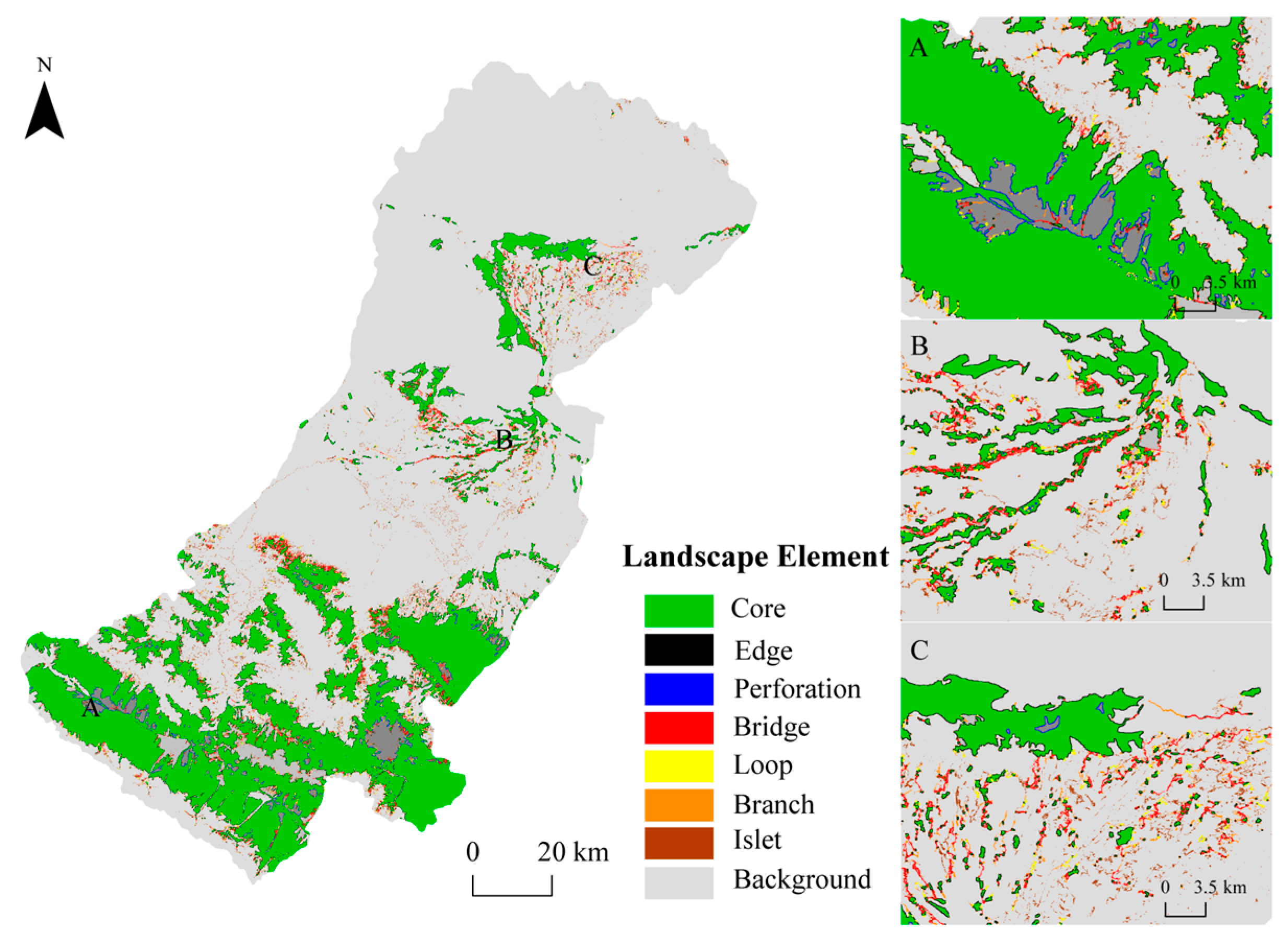

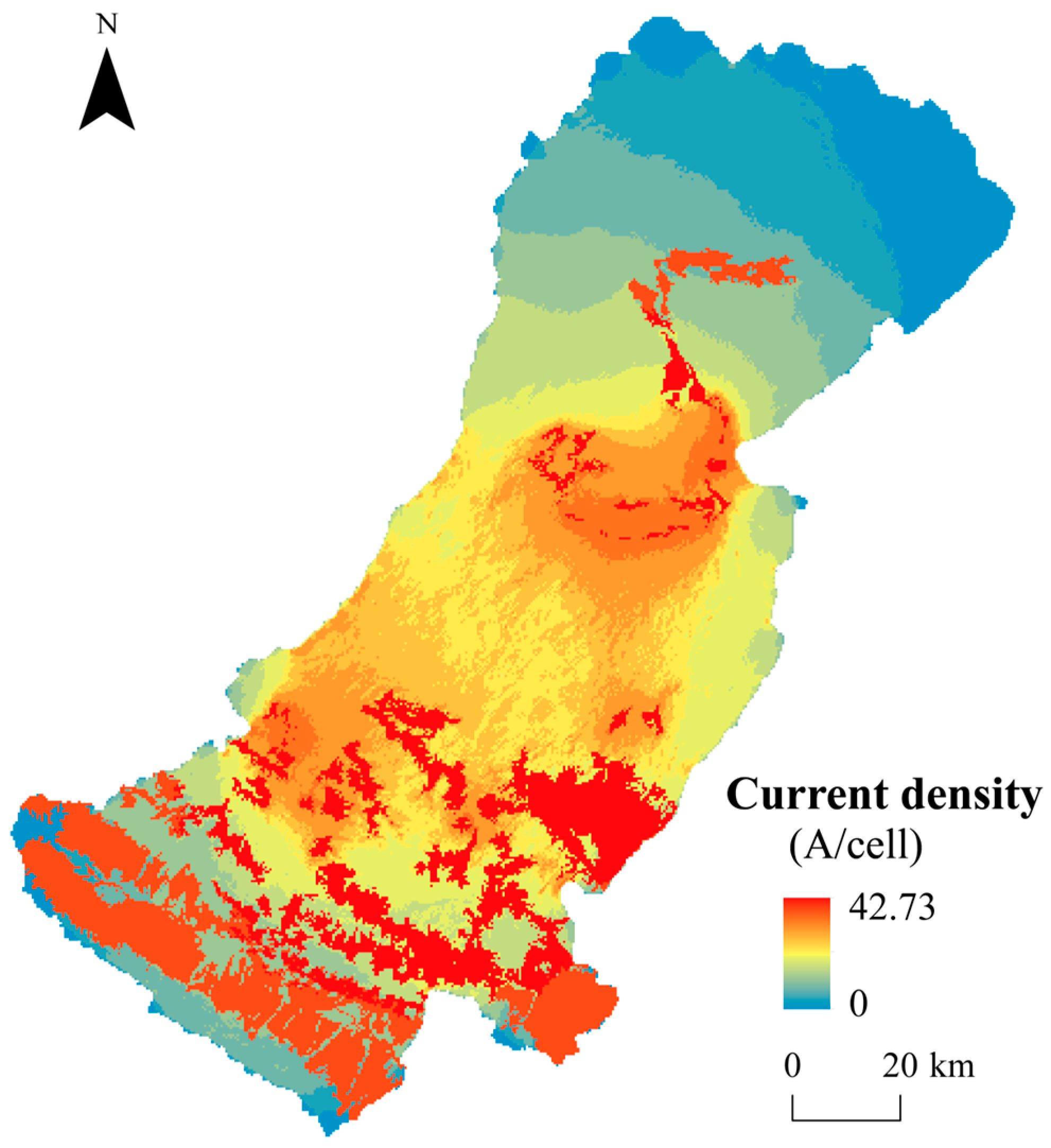
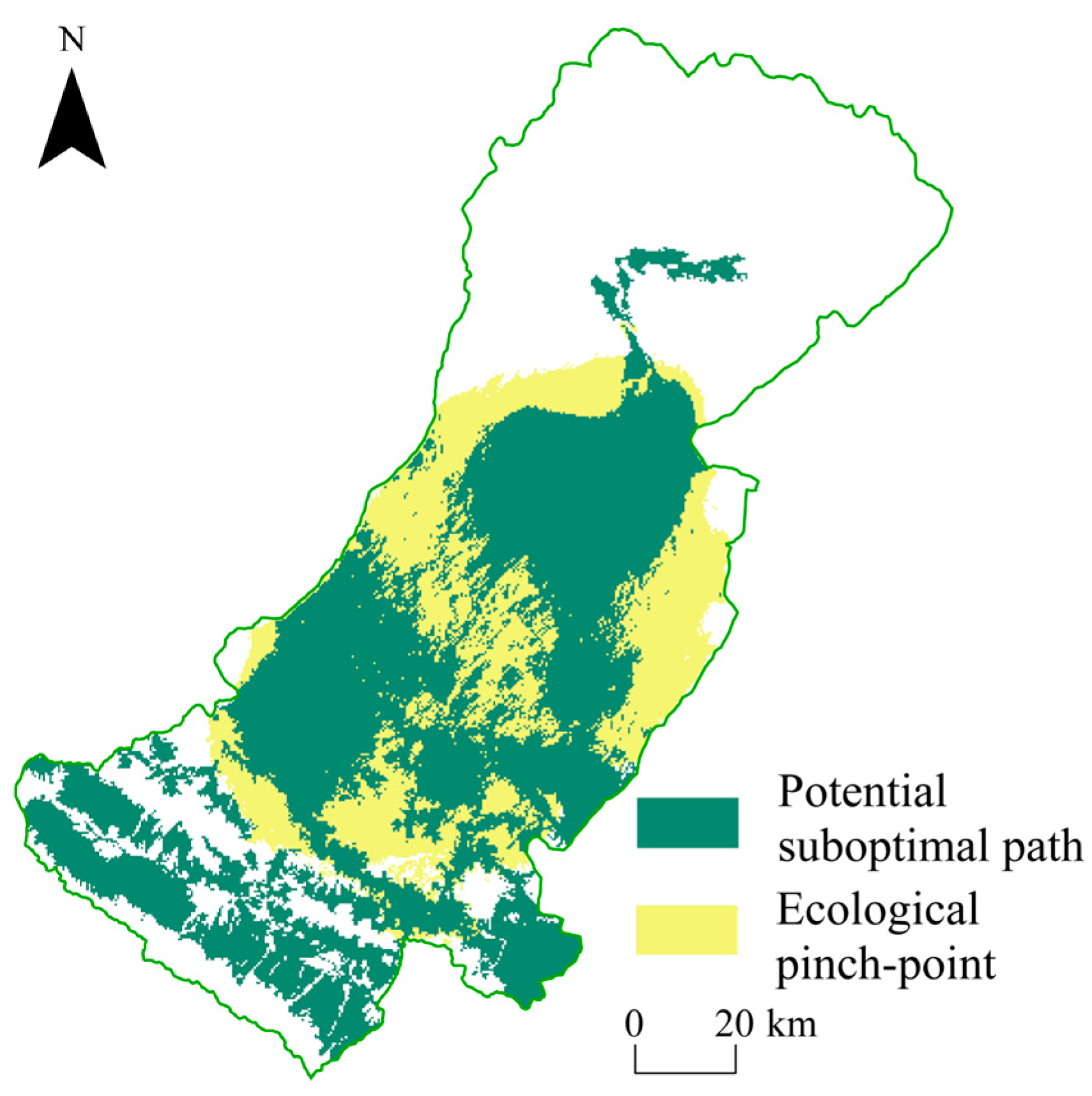
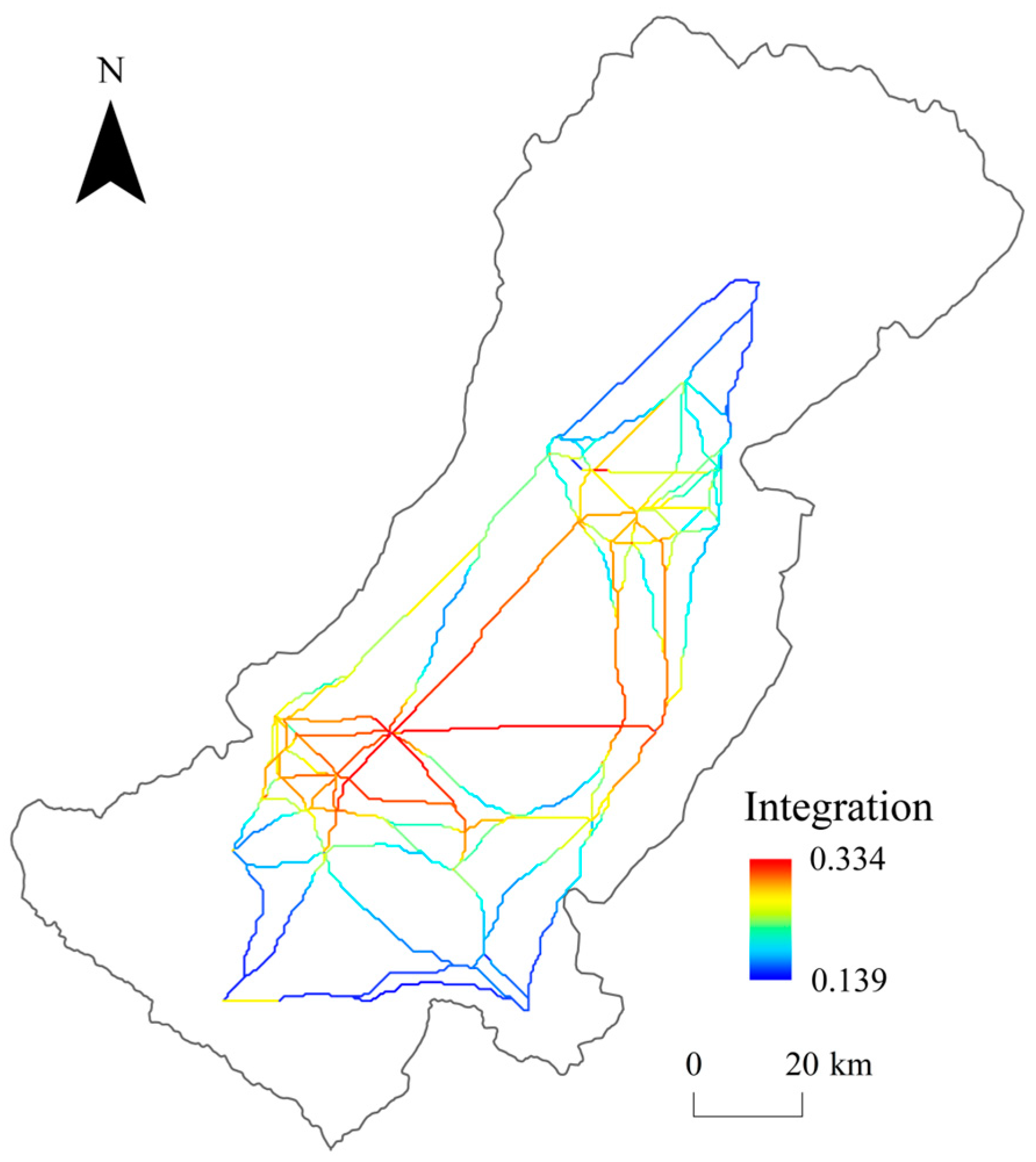

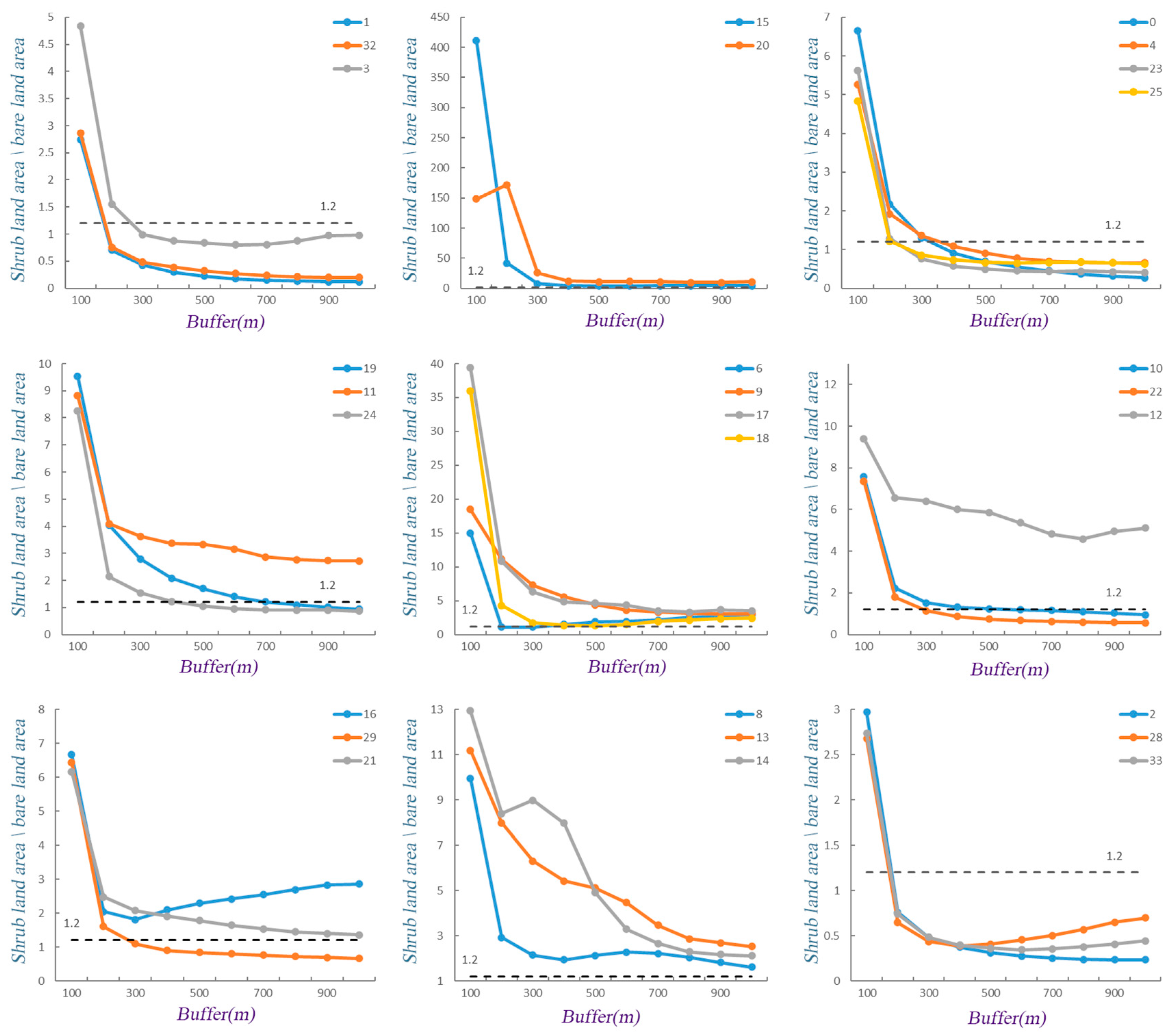
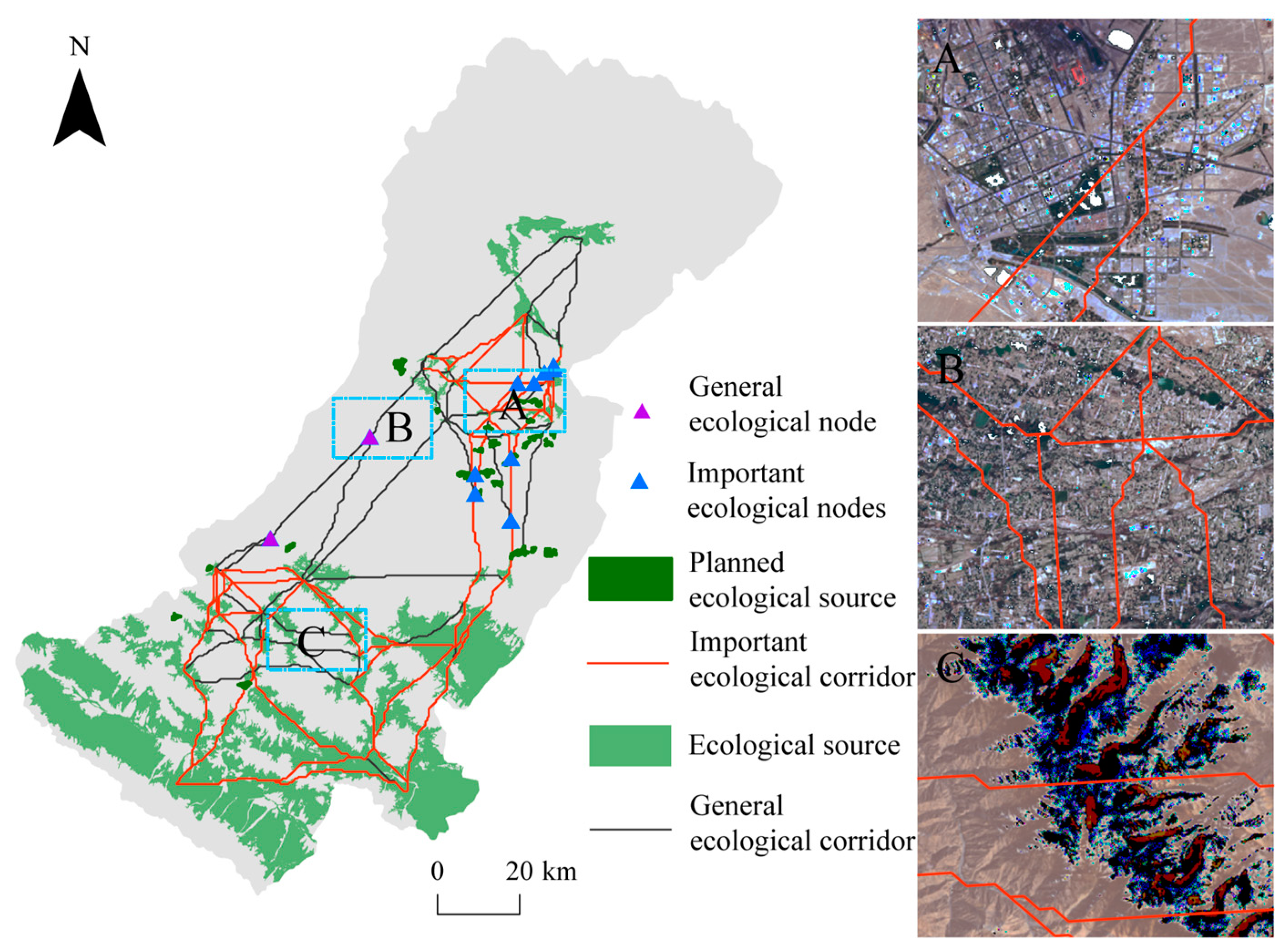

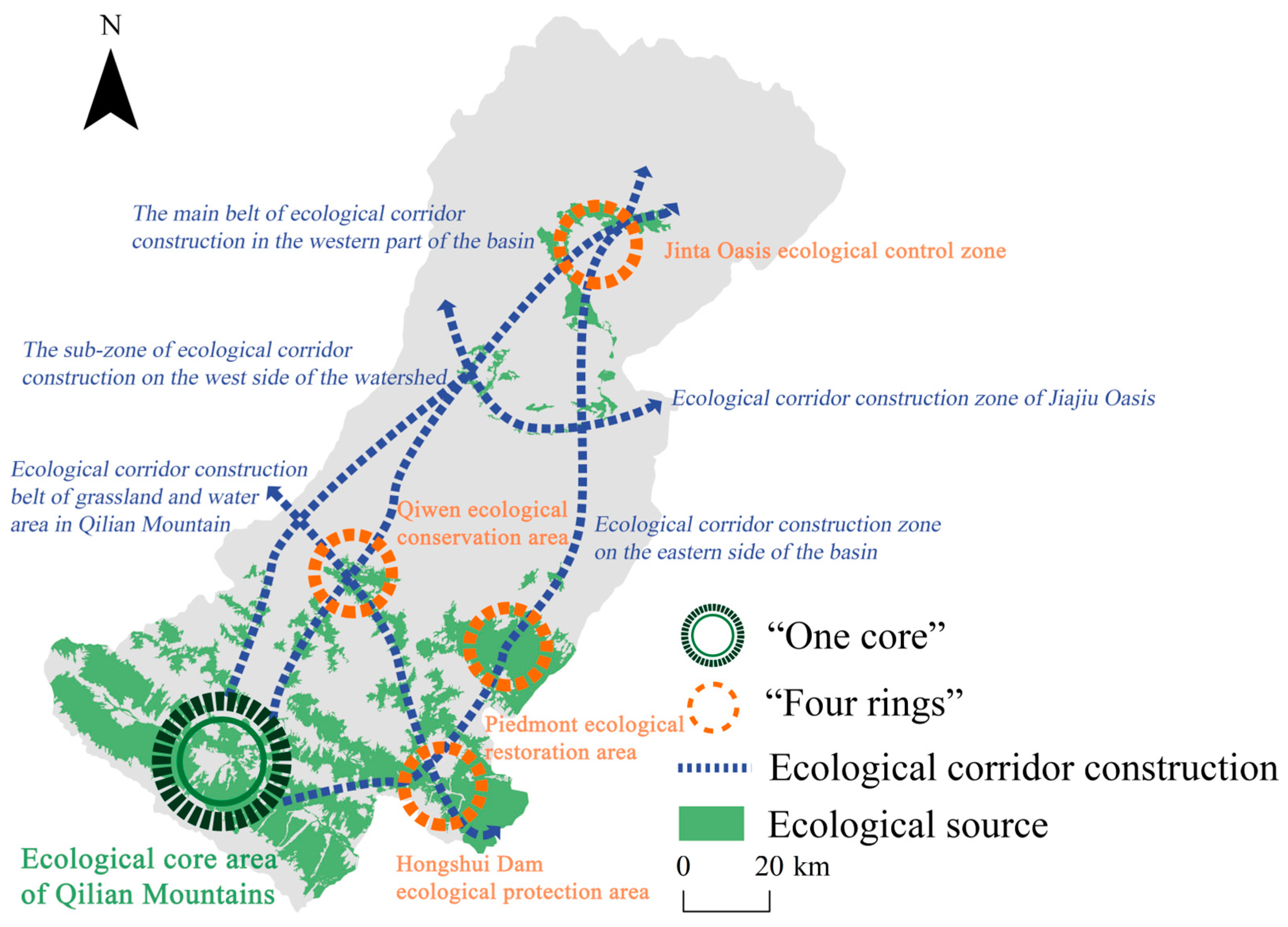
| Name | Type | Source | Website |
|---|---|---|---|
| Study area boundary | Vector | The Digital Heihe | http://heihe.tpdc.ac.cn/zh-hans/ (accessed on 8 October 2022) |
| National primary water system data | Vector | Urban and environmental geography data platform of Peking University | http://geodata.pku.edu.cn (accessed on 8 October 2022) |
| Basic geographic data | Vector | National Center for Basic Geographic Information | http://www.ngcc.cn/ (accessed on 8 October 2022) |
| Remote sensing image data | Raster | United States geological survey website | https://earthexplorer.usgs.gov/ (accessed on 8 October 2022) |
| Land use/cover data | Raster | GlobeLand30 V2020 data set | globallandcover.com (accessed on 8 October 2022) |
| DEM | Raster | Geospatial Data Cloud Platform | http://www.gscloud.cn/ (accessed on 8 October 2022) |
| Nighttime light data | Raster | National Center for Environmental Information | https://eogdata.mines.edu/products/vnl/ (accessed on 8 October 2022) |
| Landscape Type | Ecological Significance |
|---|---|
| Core | The larger habitat patches in the foreground pixels can provide larger habitats for species, which is of great significance for biodiversity conservation and is an ecological source in the EN. |
| Bridge | The narrow area connecting the core area, which represents the corridor connecting patches in the EN, is of great significance for biological migration and landscape connectivity. |
| Edge | The edge is the transition area between the core area and the predominantly non-green landscape area. |
| Loop | Corridors connecting the same core area are shortcuts for species to migrate within the same core area. |
| Perforation | The transition area between the core area and the non-green landscape patch, the inner patch edge. |
| Branch | An area where only one end is connected to an edge zone, a bridge zone, a roundabout, or a pore. |
| Islet | Isolated, fragmented patches that are not connected to each other, with low connectivity between patches and less potential for internal material and energy exchange and transfer. |
| Landscape Type | Area (km2) | Percentage of Nature Landscape Area (%) | Percentage of Research Area (%) |
|---|---|---|---|
| Core | 3250.35 | 78.10 | 20.53 |
| Bridge | 77.52 | 1.99 | 0.52 |
| Edge | 364.33 | 11.33 | 2.98 |
| Branch | 119.28 | 2.87 | 0.75 |
| Loop | 34.58 | 0.83 | 0.22 |
| Islet | 121.57 | 2.93 | 0.77 |
| Perforation | 63.94 | 1.95 | 0.51 |
| Total | 4432.39 | 100.00 | 26.28 |
| No | Priority Rank | Area (km2) | dPC | No | Priority Rank | Area (km2) | dPC |
|---|---|---|---|---|---|---|---|
| 1 | 3 | 49.05 | 13.93 | 17 | 16 | 2.54 | 2.15 |
| 2 | 14 | 1.47 | 2.61 | 18 | 20 | 4.60 | 1.90 |
| 3 | 12 | 1.69 | 3.02 | 19 | 23 | 1.97 | 1.59 |
| 4 | 19 | 1.22 | 1.98 | 20 | 30 | 8.49 | 1.07 |
| 5 | 18 | 6.02 | 2.01 | 21 | 22 | 9.93 | 1.66 |
| 6 | 24 | 3.37 | 1.48 | 22 | 28 | 1.09 | 1.13 |
| 7 | 21 | 6.11 | 1.83 | 23 | 26 | 1.37 | 1.43 |
| 8 | 9 | 7.84 | 5.64 | 24 | 2 | 28.37 | 14.44 |
| 9 | 8 | 28.85 | 9.12 | 25 | 7 | 21.87 | 10.35 |
| 10 | 25 | 5.83 | 1.46 | 26 | 13 | 4.57 | 2.77 |
| 11 | 29 | 1.06 | 1.09 | 27 | 4 | 20.72 | 13.52 |
| 12 | 6 | 20.25 | 10.99 | 28 | 17 | 6.06 | 2.03 |
| 13 | 27 | 0.97 | 1.16 | 29 | 1 | 59.38 | 31.02 |
| 14 | 15 | 3.32 | 2.59 | 30 | 10 | 10.42 | 4.36 |
| 15 | 32 | 0.71 | 1.01 | 31 | 5 | 45.52 | 12.51 |
| 16 | 31 | 1.04 | 1.04 | 32 | 11 | 31.91 | 3.32 |
Disclaimer/Publisher’s Note: The statements, opinions and data contained in all publications are solely those of the individual author(s) and contributor(s) and not of MDPI and/or the editor(s). MDPI and/or the editor(s) disclaim responsibility for any injury to people or property resulting from any ideas, methods, instructions or products referred to in the content. |
© 2023 by the authors. Licensee MDPI, Basel, Switzerland. This article is an open access article distributed under the terms and conditions of the Creative Commons Attribution (CC BY) license (https://creativecommons.org/licenses/by/4.0/).
Share and Cite
Pan, J.; Wang, Y.; Zhang, Z. Identification and Optimization of Ecological Network in Arid Inland River Basin Using MSPA and Spatial Syntax: A Case Study of Shule River Basin, NW China. Land 2023, 12, 292. https://doi.org/10.3390/land12020292
Pan J, Wang Y, Zhang Z. Identification and Optimization of Ecological Network in Arid Inland River Basin Using MSPA and Spatial Syntax: A Case Study of Shule River Basin, NW China. Land. 2023; 12(2):292. https://doi.org/10.3390/land12020292
Chicago/Turabian StylePan, Jinghu, Yimin Wang, and Zhao Zhang. 2023. "Identification and Optimization of Ecological Network in Arid Inland River Basin Using MSPA and Spatial Syntax: A Case Study of Shule River Basin, NW China" Land 12, no. 2: 292. https://doi.org/10.3390/land12020292





